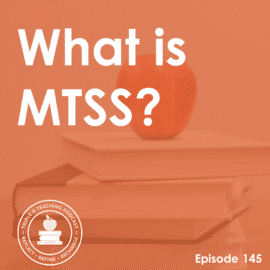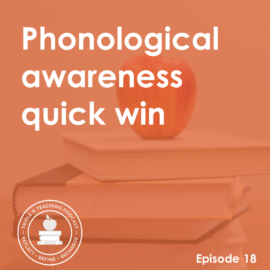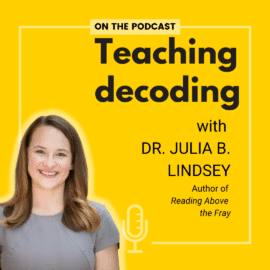
TRT Podcast #100: Alternatives to round robin reading
The jury is in! Round robin reading simply isn’t effective. Try one of these alternatives, and watch your students’ oral reading fluency grow!
Listen to the episode here
Full episode transcript
Hello, everyone! Anna Geiger here with Episode 100 of Triple R Teaching. Thank you for joining me!
The last few weeks we've enjoyed some longer interviews from some experts in the field of reading fluency so today we're going to keep it short and sweet. We're going to talk about alternatives to round robin reading.
So we all know round robin reading is where you go around the room and you take turns reading, and the teacher goes up and down the rows. Round robin reading has some other names too, names like "popcorn reading" where you may not be going around the rows, but it's rather random and different children are called on to read aloud and they may not be prepared to do that.
Honestly, when I think about round robin reading, I think about two things. I think about when I was reading in school and we did round robin reading and how hard it was to sit still and listen to the students who were struggling because I was an advanced reader and to me that was just painful. Which of course is nothing compared to how painful it was for them, but I was thinking about myself.
I can also think about something that was painful for me, truly painful, and that was when we chose teams for sports in gym class. Now this was back in the 80s and 90s, hopefully schools aren't doing this now, but the gym teachers would pick team captains and they would choose teams and every single time yours truly was the last person chosen, because team sports, basically any kind of athletics, are not my cup of tea. And so even now I'm a little scarred and don't like to play any team sports where someone's going to be watching me, which of course is every time.
I still remember how painfully embarrassing that was, and that's what we do when we have students read randomly, or we go around the room and they read and they're just not prepared, or they're not capable of reading at the same level as their peers because they haven't had time to practice the text.
We're really not accomplishing much with round robin reading because in order for fluency to develop, there needs to be a lot of practice with reading, and there isn't a lot of practice if you've got a room of twenty kids and each kid reads one-twentieth of the time.
Also, if we're creating these feelings of fear and discomfort around reading, we're not doing anybody any favors.
So what can we do instead? One of the most popular things that teachers are doing these days is called choral reading, and that's just where everyone reads altogether, which may seem a little old school like we're in a schoolhouse in the 1800s, but it really does work. So you all read at exactly the same time with you having the louder voice and leading the group for phrasing and punctuation, et cetera.
There's also something called echo reading where you read a section of text and your students read it after you. Now I used to think, "Boy, echo reading, that just sounds like they're copying you," and absolutely that's what could happen if you don't read a long enough piece of text. You want to make sure they can't just recite it, they actually have to read it after you. You're providing the model and then the class is chorally reading.
Now you may be thinking, "Okay, sounds good, but what about kids who really don't participate during that time because they can't keep up?" Well they will still benefit from choral and echo reading, but they really need a lot of one-on-one reading practice. This is when you want to make sure that you have time in your day for partner reading.
When it comes to partner reading, experts recommend pairing students up in this way. You number (just for yourself) your list of students in order from best to lowest reader, and then you break the list in half and then line up the sides.
So if you have thirty kids in your class, then child 1 and child 16 would be partners. That way you don't have a child who's really advanced with a child who's really low and you don't have two struggling readers together because then they might not be able to support each other.
So that's how you do partner reading. I've talked a lot about that in the past. I have a blog post about that that you can check out at themeasuredmom.com.
You could also do a version of partner reading called paired reading, and this is really a more supportive role for the partner. So you have a child who's struggling with reading and a tutor, a parent, a teacher, or another student who's very skilled and they start by reading the text together chorally, but there's some kind of signal that the struggling reader gives when they are ready to read on their own. So once the child feels confident, the more advanced reader is going to back away and let the child who's still learning read solo. They might tap the person on their shoulder or they might nod their head. Then they might have another signal if they want the person to join in again, maybe they need some more support. If there is a mistake that's made, the person who's tutoring stops, points to the word and asks them to try again.
You can also do a whole class fluency lesson, like the Fluency Development Lesson or FORI. I have a blog post about the Fluency Development Lesson. It's a post all about building fluency with poetry, and here's how it works. The teacher chooses a poem, probably a short one, 100-200 words, and you make a copy for all of your students. Then you read it aloud as they follow along. The next step is to read the poem chorally, and then have the students read the poem in pairs. Finally, students will perform the poem chorally, so as a class, for school visitors or staff or another class. Then they take it home to practice it some more, and then you can move the poem into their reading folders for additional practice at a future time. This Fluency Development Lesson takes place in a single day. It only has to take about fifteen minutes.
When Nancy Padak and Tim Rasinski used the Fluency Development Lesson as a way to improve the fluency of kids who were receiving Title 1, they found after several months that the students made substantial gains in fluency and overall reading, and the success students had with the Fluency Development Lesson transferred into other texts that they were reading. So definitely check out that blog post. It's called How to Improve Oral Reading Fluency Using Poetry.
Of course, we also have Reader's Theater. We've got an episode coming up soon about that next week, how to do Reader's Theater in your classroom.
We're always wanting to be thinking about how to give students more practice reading orally, because that's really going to make a difference in improving fluency.
The show notes for this episode, including links to the blog posts that I mentioned, can be found at themeasuredmom.com/episode100. Talk to you next time!
Sign up to receive email updates
Enter your name and email address below and I'll send you periodic updates about the podcast.







Leave a Comment